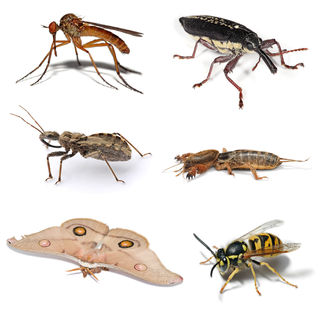
Orthoptera is an order of insects that comprises the grasshoppers, locusts and crickets, including closely related insects such as the katydids and wetas. The order is subdivided into two suborders: Caelifera – grasshoppers, locusts and close relatives; and Ensifera – crickets and close relatives.

The telephone-pole beetle is a beetle native to the eastern United States, and the only living representative of the otherwise extinct family Micromalthidae.

Grasshoppers are a group of insects belonging to the suborder Caelifera. They are among what is probably the most ancient living group of chewing herbivorous insects, dating back to the early Triassic around 250 million years ago.

Grasshopper Club Zürich, commonly referred to as simply GC, GCZ, or Grasshoppers, is a multisports club based in Zürich, Switzerland. The oldest and best known department of the club is its football team. With 27 titles, Grasshopper holds the records for winning the most national championship titles and for the most successes in the Swiss Cup tournament, 19 victories in the competition. The club is the oldest football team in Zürich and maintains a substantial rivalry with FC Zürich.

Grasshopper Manufacture Inc. is a Japanese video game developer.

The Caelifera are a suborder of orthopteran insects. They include the grasshoppers and grasshopper-like insects, as well as other superfamilies classified with them: the ground-hoppers (Tetrigoidea) and pygmy mole crickets (Tridactyloidea). The latter should not be confused with the mole crickets (Gryllotalpidae), which belong to the other Orthopteran sub-order Ensifera.

The Hardturm was a football stadium located in Zürich's Kreis 5. Opened in 1929, it was the home of the Grasshopper Club Zürich until it closed in 2007. It was a host stadium for the 1954 FIFA World Cup.

The North American green toad, Anaxyrus debilis, also known by its old name Bufo debilis, is a species of toad found in the southwestern United States in the states of Arizona, New Mexico, Colorado, Kansas, and Texas, as well as in northern Mexico in the states of Tamaulipas, San Luis Potosí, Durango, and Zacatecas. It is commonly called green toad.
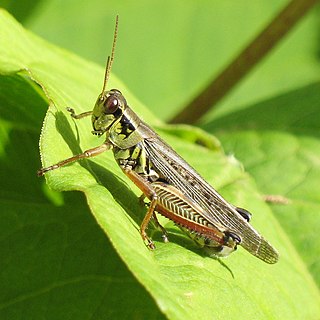
Melanoplus is a large genus of grasshoppers. They are the typical large grasshoppers in North America. A common name is spur-throat grasshoppers, but this more typically refers to members of the related subfamily Catantopinae.

A Grasshopper is a sweet, mint-flavored, after-dinner drink. The name of the drink derives from its green color, which comes from crème de menthe. A bar in the French Quarter of New Orleans, Louisiana, Tujague's, claims the drink was invented in 1918 by its owner, Philip Guichet. The drink gained popularity during the 1950s and 1960s throughout the American South.
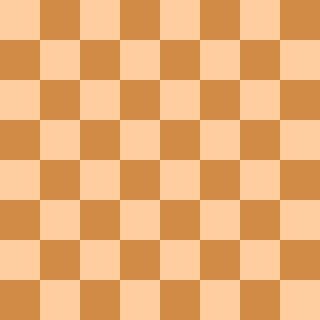
Grasshopper chess is a chess variant, in which the pawns are allowed to promote to a fairy piece, the grasshopper. The grasshopper must hop over other pieces in order to move or capture.

Parietaria debilis, commonly known as pellitory, small-flower pellitory, or native pellitory, is a herb native to Australia and New Zealand.
Plantago debilis is a species of herb native to Australia. Common names include shade plantain and weak plantain.
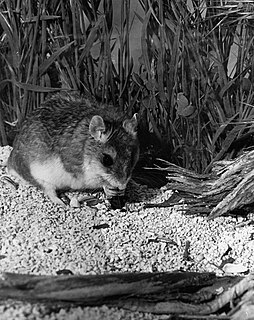
Grasshopper mice are rodents of the North American genus Onychomys. Grasshopper mice feed on insects and other arthropods.

The Grasshopper and the Ants is a 1934 American animated short film produced by Walt Disney Productions and released by United Artists. Part of the Silly Symphonies series, the film is an adaptation of The Ant and the Grasshopper, one of Aesop's Fables. It was directed by Wilfred Jackson and stars Pinto Colvig as the voice of the grasshopper "Hop."
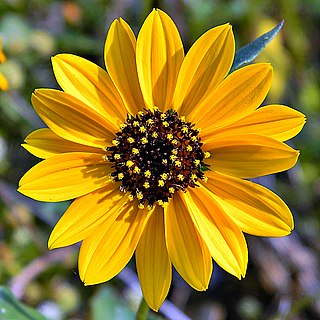
Helianthus debilis is a species of sunflower known by the common names cucumberleaf sunflower, beach sunflower, weak sunflower, and East Coast dune sunflower. It is native to the United States, where it can be found along the Atlantic and Gulf Coasts. It is known elsewhere as an introduced species, such as South Africa, Australia, Taiwan, Slovakia, and Cuba.

Oxalis debilis, the large-flowered pink-sorrel or pink woodsorrel, is a perennial plant and herb in the Oxalidaceae family. Its original distribution is South America but has become a very cosmopolitan species, occurring in all continents except Antarctica. It can be found in both temperate and tropical areas.
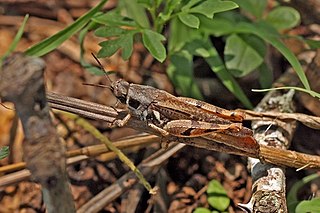
Catantops is a genus of grasshoppers in the tribe Catantopini and is typical of the subfamily Catantopinae. Species can be found in Africa, including Madagascar and subcontinental India.
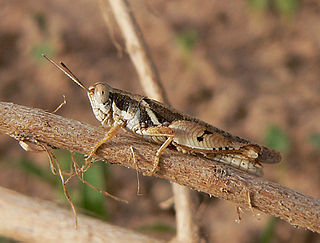
Cryptocatantops is a genus of grasshoppers in the subfamily Catantopinae, a group of insects primarily found in Africa. As numerous other genera, it is not yet assigned to a particular tribe.

